The Effect of Soaking Root Fertilizer on Promoting the Seedling Early Growth and Root Development of Eucalyptus urograndis
Abstract
:1. Introduction
2. Materials and Methods
2.1. Plant Materials and Environmental Conditions
2.2. Fertilizer Preparation and Handling
2.3. Experimental Design
2.4. The Determination of Growth Characteristics, Root Parameters, and Biomass Per Organ
2.5. The Determination of Leaf and Photosynthetic Characteristics
2.6. The Determination of Total Nutrient Uptake
2.7. Comprehensive Evaluation of the Soaking Root Fertilizer Treatments
2.8. Data Processing and Statistical Analysis
3. Results
3.1. The Effects of Different Soaking Root Fertilizer Treatments on Seedling Growth Properties
3.2. The Effects of Different Soaking Root Fertilizer Treatments on the Root Parameters of Seedlings
3.3. The Effects of Different Soaking Root Fertilizer Treatments on the Biomass of Seedling Organs
3.4. The Effects of Different Soaking Root Fertilizer Treatments on Seedling Photosynthesis
3.5. The Effects of Different Soaking Root Fertilizer Treatments on Total Nutrient Uptake and Concentrations in Seedlings and Organs
3.6. The Comprehensive Evaluation of E. urograndis Seedlings with Different Soaking Root Fertilizer Formulas
3.7. Comprehensive Evaluation of E. urograndis Seedlings with Different Soaking Root Fertilizer Formulas
4. Discussion
4.1. The Effects of Different Soaking Root Fertilizer Treatments on Seedling Growth
4.2. Effects of Different Soaking Root Fertilizer Treatments on Root of Seedlings
4.3. The Effects of Different Soaking Root Fertilizer Treatments on the Biomass of Seedlings
4.4. The Effects of Different Soaking Root Fertilizer Formulas on Photosynthetic Characteristics and Nutrient Accumulation in Seedlings
4.5. Comprehensive Evaluation of Different Fertilization Methods and the Influence of the Basal Treatment on E. urograndis Seedlings
5. Conclusions
Author Contributions
Funding
Informed Consent Statement
Data Availability Statement
Acknowledgments
Conflicts of Interest
References
- Xie, Y. Primary Studies on Sustainable Management Strategy of Eucalyptus Plantation in China. World For. Res. 2003, 16, 59–64. [Google Scholar] [CrossRef]
- Huang, G.; Zhao, Q. The History, status Quo, ecological Problems and Countermeasures of Eucalyptus Plantations in Guangxi. Acta Ecol. Sin. 2014, 34, 5142–5152. [Google Scholar] [CrossRef]
- Assis, T.; Abad, J.; Aguiar, A. Melhoramento Genético Do Eucalipto. In Silvicultura do Eucalipto no Brasil, 1st ed.; Editora UFSM: Santa Maria, Brazil, 2015; pp. 217–244. ISBN 978.85.7391.223-4. [Google Scholar]
- Joseph Wright, S. Plant Responses to Nutrient Addition Experiments Conducted in Tropical Forests. Ecol. Monogr. 2019, 89, e01382. [Google Scholar] [CrossRef]
- Gonçalves, J.; Alcarde Alvares, C.; Hübner, A.; Junior, J. Caracterização Edafoclimática e Manejo de Solos Das Áreas Com Plantações de Eucalipto. In Silvicultura do Eucalipto no Brasil, 1st ed.; Editora UFSM: Santa Maria, Brazil, 2015; pp. 113–155. ISBN 978-85-7391-223-4. [Google Scholar]
- York, L.; Nord, E.; Lynch, J. Integration of Root Phenes for Soil Resource Acquisition. Front. Plant Sci. 2013, 4, 355. [Google Scholar] [CrossRef] [PubMed]
- Grossnickle, S.C.; MacDonald, J.E. Why Seedlings Grow: Influence of Plant Attributes. New For. 2018, 49, 1–34. [Google Scholar] [CrossRef]
- Brunner, I.; Herzog, C.; Dawes, M.A.; Arend, M.; Sperisen, C. How Tree Roots Respond to Drought. Front. Plant Sci. 2015, 6, 547. [Google Scholar] [CrossRef]
- Tang, W.; Tang, A.Y. MicroRNAs Associated with Molecular Mechanisms for Plant Root Formation and Growth. J. For. Res. 2016, 27, 1–12. [Google Scholar] [CrossRef]
- Ambroise, V.; Legay, S.; Guerriero, G.; Hausman, J.-F.; Cuypers, A.; Sergeant, K. The Roots of Plant Frost Hardiness and Tolerance. Plant Cell Physiol. 2020, 61, 3–20. [Google Scholar] [CrossRef]
- Gruffman, L.; Ishida, T.; Nordin, A.; Nasholm, T. Cultivation of Norway Spruce and Scots Pine on Organic Nitrogen Improves Seedling Morphology and Field Performance. For. Ecol. Manag. 2012, 276, 118–124. [Google Scholar] [CrossRef]
- Zou, J.; Niu, Y.; Song, F.; Xing, X.; Chen, G.; Zhuge, Y.; Lou, Y. Intensification of the Intercropping Effect of Phytoremediation of Soil Contaminated with Cadmium and Zinc Using Potassium Fertilizer. J. Agro-Environ. Sci. 2022, 41, 304–312. [Google Scholar] [CrossRef]
- Kazantseva, O.; Bingham, M.; Simard, S.W.; Berch, S.M. Effects of Growth Medium, Nutrients, Water, and Aeration on Mycorrhization and Biomass Allocation of Greenhouse-Grown Interior Douglas-Fir Seedlings. Mycorrhiza 2009, 20, 51–66. [Google Scholar] [CrossRef] [PubMed]
- Chu, X.; Wang, X.; Zhang, D.; Wu, X.; Zhou, Z. Effects of Fertilization and Container-Type on Nutrient Uptake and Utilization by Four Subtropical Tree Seedlings. J. For. Res. 2020, 31, 1201–1213. [Google Scholar] [CrossRef]
- Zuffo, A.M.; Júnior, J.M.Z.; Carvalho, R.M.; dos Santos, A.S.; da Silva Oliveira, J.B.; Fonseca, W.L. Response of Baru (Dipteryx Alata Vog.) Seedlings to Liming and NPK Application. J. Plant Nutr. 2017, 40, 1332–1338. [Google Scholar] [CrossRef]
- Yang, Z.; Feng, J.; Wu, X.; Chen, L.; Yu, X.; Chen, L. Effects of N, P, and K Fertilization on Nutrient Uptakes and Utilizations of Phoebe bournei Seedlings. Chin. J. Ecol. 2021, 40, 998–1011. [Google Scholar]
- Shen, Y.; Gilbert, G.S.; Li, W.; Fang, M.; Lu, H.; Yu, S. Linking Aboveground Traits to Root Traits and Local Environment: Implications of the Plant Economics Spectrum. Front. Plant Sci. 2019, 10, 1412. [Google Scholar] [CrossRef] [PubMed]
- Zhou, Z.; Liang, K.; Xu, D.; Zhang, Y.; Huang, G.; Ma, H. Effects of Calcium, Boron and Nitrogen Fertilization on the Growth of Teak (Tectona Grandis) Seedlings and Chemical Property of Acidic Soil Substrate. New For. 2012, 43, 231–243. [Google Scholar] [CrossRef]
- Yang, Z.-J.; Wu, X.-H.; Chen, L.-H.; Huang, L.-M.; Chen, Y.; Wu, J.; El-Kassaby, Y.A.; Grossnickle, S.C.; Feng, J.-L. Fertilization Regulates Accumulation and Allocation of Biomass and Nutrients in Phoebe bournei Seedlings. Agriculture 2021, 11, 1187. [Google Scholar] [CrossRef]
- Chen, S.X.; Wu, Z.H.; Li, Z.H.; Xie, Y.J.; Li, T.H.; Zhou, Q.Y.; Arnold, R.J. Selection of Species for Solid Wood Production in Southern China. J. Trop. For. Sci. 2010, 22, 308–316. [Google Scholar]
- da Silva, D.E.M.; de Azevedo, L.A.S.; de Souza Poltronieri, T.P. Avaliação Da Resistência de Espécies de Eucalipto à Ferrugem (Puccinia Psidii Winter). Summa Phytopathol. 2014, 40, 54–62. [Google Scholar] [CrossRef]
- Li, G.; Xu, J.; Li, C.; Chen, J.; Guo, D.; Lu, H. Study on the Grouped and Genetic Analysis of Eucalyptus Hybrids in Northern Guangxi. J. Cent. South Univ. For. 2021, 41, 8–15. [Google Scholar]
- Cheng, S.; Widden, P.; Messier, C. Light and Tree Size Influence Belowground Development in Yellow Birch and Sugar Maple. Plant Soil 2005, 270, 321–330. [Google Scholar] [CrossRef]
- Turnbull, J.W. Development of Sustainable Forestry Plantations in China: A Review; Australian Centre for International Agricultural Research: Canberra, Australia, 2007.
- Qiu, Q.; Pan, X.; Li, J.; He, X.; Su, Y.; Dong, L. Comparison on Photosynthetic and Roots Characteristics of Eucalyptus Urophylla × Eucalyptus Grandis and Bamboo-Willow Seedlings. J. Cent. South Univ. For. Technol. 2014, 34, 53–59. [Google Scholar]
- Xu, W.; Liu, J.; Liu, X.; Li, K.; Zhang, D.; Yan, J. Fine Root Production, Turnover, and Decomposition in a Fast-Growth Eucalyptus Urophylla Plantation in Southern China. J. Soils Sediments 2013, 13, 1150–1160. [Google Scholar] [CrossRef]
- Xu, D.P.; Dell, B. Nutrient Management of Eucalypt Plantations in South China. In Eucalyptus plantations: Research, management and development, Proceedings of the international symposium, Guangzhou, China, 1–6 September 2002; Wei, R.P., Xu, D.P., Eds.; World Scientific Pub. Co.: Singapore, 2003; pp. 269–289. [Google Scholar]
- Chen, W.; Teng, Y.; Li, Z.; Liu, W.; Ren, W.; Luo, Y.; Christie, P. Mechanisms by Which Organic Fertilizer and Effective Microbes Mitigate Peanut Continuous Cropping Yield Constraints in a Red Soil of South China. Appl. Soil Ecol. 2018, 128, 23–34. [Google Scholar] [CrossRef]
- Zhang, Y.; Zhou, Z.; Yang, Q. Nitrogen (N) Deposition Impacts Seedling Growth of Pinus Massoniana via N:P Ratio Effects and the Modulation of Adaptive Responses to Low P (Phosphorus). PLoS ONE 2013, 8, e79229. [Google Scholar] [CrossRef]
- Salifu, K.; Timmer, V. Optimizing Nitrogen Loading of Picea Mariana Seedlings during Nursery Culture. Can. J. For. Res. 2003, 33, 1287–1294. [Google Scholar] [CrossRef]
- LeBauer, D.S.; Treseder, K.K. Nitrogen Limitation of Net Primary Productivity in Terrestrial Ecosystems is Globally Distributed. Ecology 2008, 89, 371–379. [Google Scholar] [CrossRef]
- Mengel, K.; Hütsch, B.; Kane, Y. Nitrogen Fertilizer Application Rates on Cereal Crops According to Available Mineral and Organic Soil Nitrogen. Eur. J. Agron. 2006, 24, 343–348. [Google Scholar] [CrossRef]
- Li, S.; Tan, D.; Wu, X.; Degré, A.; Long, H.; Zhang, S.; Lu, J.; Gao, L.; Zheng, F.; Liu, X.; et al. Negative Pressure Irrigation Increases Vegetable Water Productivity and Nitrogen Use Efficiency by Improving Soil Water and NO3—N Distributions. Agric. Water Manag. 2021, 251, 106853. [Google Scholar] [CrossRef]
- Mikkelsen, R.L.; Roberts, T.L. Inputs: Potassium Sources for Agricultural Systems. In Proceedings of the Improving Potassium Recommendations for Agricultural Crops; Murrell, T.S., Mikkelsen, R.L., Sulewski, G., Norton, R., Thompson, M.L., Eds.; Springer International Publishing: Cham, Switzerland, 2021; pp. 47–73. [Google Scholar]
- Feng, Q.; Ma, G.; Chen, M.; Li, C.; Shi, W. Effects of Cl− on Transformation of Nitrogenous Fertilizers, Microbes and Enzyme Activities in Soil. J. Zhejiang Agric. Univ. 1993, 19, 357–361. [Google Scholar]
- Apostol, K.; Zwiazek, J.; MacKinnon, M. NaCl and Na2SO4 Alter Responses of Jack Pine (Pinus Banksiana) Seedlings to Boron. Plant Soil 2002, 240, 321–329. [Google Scholar] [CrossRef]
- Franklin, J.; Zwiazek, J.; Renault, S.; Croser, C. Growth and Elemental Composition of Jack Pine (Pinus Banksiana) Seedlings Treated with Sodium Chloride and Sodium Sulfate. Trees-Struct. Funct. 2002, 16, 325–330. [Google Scholar] [CrossRef]
- Redfield, E.; Zwiazek, J. Drought Tolerance Characteristics of Black Spruce (Picea Mariana) Seedlings in Relation to Sodium Sulfate and Sodium Chloride Injury. Can. J. Bot.-Rev. Can. De Bot. 2002, 80, 773–778. [Google Scholar] [CrossRef]
- Hara, Y. Suppressive Effect of Sulfate on Establishment of Rice Seedlings in Submerged Soil May Be Due to Sulfide Generation around the Seeds. Plant Prod. Sci. 2013, 16, 50–60. [Google Scholar] [CrossRef]
- Zhang, Z. The Effect of Different Substrate and Fertilization on Tissue Culture Seedlings of Eucalyptus Urophylla × Eucalyptus Grandis. J. Fujian For. Sci. Tech. 2003, 30, 65–67. [Google Scholar]
- Yang, X. Experiment of Different Kinds of Basal Fertilizer for Short Rotation Artificial Forest of Eucalyptus. China For. Sci. Technol. 2004, 13–16. [Google Scholar]
- Gao, X.; Ma, W.; Du, S.; Zhang, F.; Mao, D. Current Status and Problems of Fertilization In China. Chin. J. Soil Sci. 2001, 32, 258–261. [Google Scholar] [CrossRef]
- Opoku-Kwanowaa, Y.; Furaha, R.K.; Yan, L.; Wei, D. Effects of Planting Field on Groundwater and Surface Water Pollution in China. CLEAN—Soil Air Water 2020, 48, 1900452. [Google Scholar] [CrossRef]
- Wang, C.N.; Du, C.; Yang, Z.M.; Wang, H.L.; Shang, L.J.; Liu, L.L.; Yang, Z.Y.; Song, S.Y.; Amanullah, S. Study on the cultivation of seedlings using buds of potato (Solanum tuberosum L.). Peer J. 2022, 10, e13804. [Google Scholar] [CrossRef]
- Zhang, Y.; Xie, Z.; Wang, Y.; Su, P.; An, L.; Gao, H. Effect of Water Stress on Leaf Photosynthesis, Chlorophyll Content, and Growth of Oriental Lily. Russ. J. Plant Physiol. 2011, 58, 844–850. [Google Scholar] [CrossRef]
- Huang, R.; Lan, T.; Song, X.; Li, J.; Ling, J.; Deng, O.P.; Wang, C.Q.; Gao, X.S.; Li, Q.Q.; Tang, X.Y.; et al. Soil labile organic carbon impacts C:N:P stoichiometry in urban park green spaces depending on vegetation types and time after planting. Appl. Soil Ecol. 2021, 163, 103926. [Google Scholar] [CrossRef]
- Rodríguez, Y.; Maudier, B.; Zagal, E.; Hernández, P. Effects of Wood Ash on Nutrients and Heavy Metal(oid)s Mobility in an Ultisol. Int. J. Environ. Res. Public Health 2019, 16, 1246. [Google Scholar] [CrossRef] [PubMed]
- Lv, S.; Wang, X.; Liu, G. A Simple and Reasonable Calculation Equation of Balanced Fertilization. Agronomy 2015, 5, 180–187. [Google Scholar] [CrossRef]
- Li, H.; Chen, S. Studies on the Base Fertilizer Utilization Rate and Nutrient Demand of Eucalypt. Master’s Thesis, Chinese Academy of Forestry, Beijing, China, 2012. [Google Scholar]
- Dell, B.; Xu, D.; Rogers, C.; Huang, L. Micronutrinet Disorders in Eucalypt Plantations: Causes, Symptoms, Identification, Impact and Management. In Proceedings of the International Symposium, Guangzhou, China, 1–6 September 2002; pp. 241–252. [Google Scholar]
- Tng, D.Y.P.; Janos, D.P.; Jordan, G.J.; Weber, E.; Bowman, D.M.J.S. Phosphorus Limits Eucalyptus Grandis Seedling Growth in an Unburnt Rain Forest Soil. Front. Plant Sci. 2014, 5, 527. [Google Scholar] [CrossRef]
- Albaugh, T.J.; Albaugh, J.M.; Fox, T.R.; Allen, H.L.; Rubilar, R.A.; Trichet, P.; Loustau, D.; Linder, S. Tamm Review: Light Use Efficiency and Carbon Storage in Nutrient and Water Experiments on Major Forest Plantation Species. For. Ecol. Manag. 2016, 376, 333–342. [Google Scholar] [CrossRef]
- Hernandez, M.J.; Montes, F.; Ruiz, F.; Lopez, G.; Pita, P. The Effect of Vapour Pressure Deficit on Stomatal Conductance, Sap PH and Leaf-Specific Hydraulic Conductance in Eucalyptus Globulus Clones Grown under Two Watering Regimes. Ann. Bot. 2016, 117, 1063–1071. [Google Scholar] [CrossRef]
- Stape, J.L.; Binkley, D.; Ryan, M.G. Eucalyptus Production and the Supply, Use and Efficiency of Use of Water, Light and Nitrogen across a Geographic Gradient in Brazil. For. Ecol. Manag. 2004, 193, 17–31. [Google Scholar] [CrossRef]
- Jacobs, D.F.; Rose, R.; Haase, D.L.; Alzugaray, P.O. Fertilization at Planting Impairs Root System Development and Drought Avoidance of Douglas-Fir (Pseudotsuga Menziesii) Seedlings. Ann. For. Sci. 2004, 61, 643–651. [Google Scholar] [CrossRef]
- Davis, A.S.; Jacobs, D.F. Quantifying Root System Quality of Nursery Seedlings and Relationship to Outplanting Performance. New For. 2005, 30, 295–311. [Google Scholar] [CrossRef]
- Attiwill, P.; Adams, M. Nutrition of Eucalypts; CSIRO Publishing: Clayton, Australia, 1996; ISBN 978-0-643-10592-8. [Google Scholar]
- Xu, R.; Coventry, D.R. Acidification as Influenced by Some Agricultural Practices. Agro-Environ. Prot. 2002, 21, 385–388. [Google Scholar] [CrossRef]
- Ritchie, G.S.P. 1—The Chemical Behaviour of Aluminium, Hydrogen and Manganese in Acid Soils; Elsevier: Amsterdam, The Netherlands, 1989. [Google Scholar]
- Castro, M.S.; Morgan, R.P. Input–Output Budgets of Major Ions for a Forested Watershed in Western Maryland. Water Air Soil Pollut. 2000, 119, 121–137. [Google Scholar] [CrossRef]
- Liu, H.; Wang, J.; Liu, J.; Liu, T.; Xue, S. Hydrogen Sulfide (H2S) Signaling in Plant Development and Stress Responses. aBIOTECH 2021, 2, 32–63. [Google Scholar] [CrossRef]
- Graciano, C.; Goya, J.F.; Frangi, J.L.; Guiamet, J.J. Fertilization with Phosphorus Increases Soil Nitrogen Absorption in Young Plants of Eucalyptus Grandis. For. Ecol. Manag. 2006, 236, 202–210. [Google Scholar] [CrossRef]
- de Souza Kulmann, M.S.; Arruda, W.S.; Vitto, B.B.; Schneider de Souza, R.O.; Pasquetti Berghetti, A.L.; Tarouco, C.P.; Araujo, M.M.; Nicoloso, F.T.; Schumacher, M.V.; Brunetto, G. Morphological and Physiological Parameters Influence the Use Efficiency of Nitrogen and Phosphorus by Eucalyptus Seedlings. New For. 2022, 53, 431–448. [Google Scholar] [CrossRef]
- Li, Y.; Cha, Z.; Luo, W.; Bei, M.; Lin, Q. The Symptoms of Nitrogen, Phosphorus and Potassium Deficiency in Eucalyptus Seedlings. Chin. J. Soil Sci. 2009, 40, 290–293. [Google Scholar]
- Li, L.; Yin, Z.; Ya, H.; Li, H.; Liu, C. Influence of N, P, K, Ca Deficiency on Growth of Moringa Oleifera Lam Seedlings. Chin. Agric. Sci. Bull. 2015, 31, 52–56. [Google Scholar] [CrossRef]
- Xue, X.; Wu, X.; Luo, X.; Wang, W.; Wang, D.; Zhang, Y.; Zhao, C. Effects of Potassium and Magnesium Deficiency on Leaf Physiological Characteristics and Chloroplast Ultrastructure of Anther Culture Seedling of Rubber Tree (Hevea Brasiliensis). Chin. J. Trop. Crops 2019, 40, 1507–1514. [Google Scholar] [CrossRef]
- Wang, Y.; Wu, W.-H. Potassium Transport and Signaling in Higher Plants. Annu. Rev. Plant Biol. 2013, 64, 451–476. [Google Scholar] [CrossRef]
- Hafsi, C.; Debez, A.; Abdelly, C. Potassium Deficiency in Plants: Effects and Signaling Cascades. Acta Physiol. Plant. 2014, 36, 1055–1070. [Google Scholar] [CrossRef]
- Schachtman, D.P. The Role of Ethylene in Plant Responses to K+ Deficiency. Front. Plant Sci. 2015, 6, 1153. [Google Scholar] [CrossRef]
- Sustr, M.; Soukup, A.; Tylova, E. Potassium in Root Growth and Development. Plants 2019, 8, 435. [Google Scholar] [CrossRef]
- Ao, Y.; Liu, J.; Chen, H.; Ruan, F.; Liu, J.; Zhang, X. Annual Growth Rhythm and Character Correlation Analysis of 1-Year-Old Xanthoceras Sorbi Folium Seedling from Different Provenances. J. Northwest For. Univ. 2019, 34, 91–97. [Google Scholar]
- Ma, Q.; Zhang, F.; Rengel, Z.; Shen, J. Localized Application of NH4+-N plus P at the Seedling and Later Growth Stages Enhances Nutrient Uptake and Maize Yield by Inducing Lateral Root Proliferation. Plant Soil 2013, 372, 65–80. [Google Scholar] [CrossRef]
- Wang, S.; Cai, J.; Liu, J.; Wang, D.; Fan, X. Effect of Soil Substrate and Shade on the Seedling Components and Biomass Allocation of Zoysia Japonica in the Winter. Acta Agrestia Sin. 2016, 24, 1296–1303. [Google Scholar] [CrossRef]
- de Lima Neto, A.J.; Lima Neves, J.C.; Prieto Martinez, H.E.; Sousa, J.S.; Fernandes, L.V. Nutrient Accumulation and Nutritional Efficiency in Eucalyptus. J. Plant Nutr. 2021, 44, 2421–2434. [Google Scholar] [CrossRef]
- Bulgarelli, R.G.; de Oliveira Silva, F.M.; Bichara, S.; Andrade, S.A.L.; Mazzafera, P. Eucalypts and low phosphorus availability: Between responsiveness and efficiency. Plant Soil 2019, 445, 349–368. [Google Scholar] [CrossRef]
- Tilman, D. The Resource-Ratio Hypothesis of Plant Succession. Am. Nat. 1985, 125, 827–852. [Google Scholar] [CrossRef]
- Montgomery, R. Relative Importance of Photosynthetic Physiology and Biomass Allocation for Tree Seedling Growth across a Broad Light Gradient. Tree Physiol. 2004, 24, 155–167. [Google Scholar] [CrossRef]
- Chen, Z.; Gao, X.; Zhou, W.; Chen, X.; He, X. Effect of Fertilization on Photosynthetic and Nutrient Characteristics of Moringa Oleifera Seedlings. For. Environ. Sci. 2019, 35, 35–42. [Google Scholar]
- Li, J.; Luo, G.; Shaibu, A.S.; Li, B.; Zhang, S.; Sun, J. Optimal Fertilization Level for Yield, Biological and Quality Traits of Soybean under Drip Irrigation System in the Arid Region of Northwest China. Agronomy 2022, 12, 291. [Google Scholar] [CrossRef]
- Chu, X.; Sun, X.; Zhang, S.; Xu, C.; Wang, L.; Cheng, X. Effect of Controlled Release Fertilizers on Net Container Seedlings Growth of Larix Kaempferi. For. Res. 2012, 25, 697–702. [Google Scholar]
- Tomiki, T.; Saitou, N. Phylogenetic Analysis of Proteins Associated in the Four Major Energy Metabolism Systems: Photosynthesis, Aerobic Respiration, Denitrification, and Sulfur Respiration. J. Mol. Evol. 2004, 59, 158–176. [Google Scholar] [CrossRef] [PubMed]
- Sharma, T.; Dreyer, I.; Riedelsberger, J. The Role of K+ Channels in Uptake and Redistribution of Potassium in the Model Plant Arabidopsis Thaliana. Front. Plant Sci. 2013, 4, 224. [Google Scholar] [CrossRef] [PubMed]
- Zhao, D.; Oosterhuis, D.M.; Bednarz, C.W. Influence of Potassium Deficiency on Photosynthesis, Chlorophyll Content, and Chloroplast Ultrastructure of Cotton Plants. Photosynthetica 2001, 39, 103–109. [Google Scholar] [CrossRef]
- Schaberg, P.G.; Dehayes, D.H.; Hawley, G.J.; Strimbeck, G.R.; Cumming, J.R.; Murakami, P.F.; Borer, C.H. Acid Mist and Soil Ca and Al Alter the Mineral Nutrition and Physiology of Red Spruce. Tree Physiol. 2000, 20, 73–85. [Google Scholar] [CrossRef]
- Yang, M.; Tan, L.; Xu, Y.; Zhao, Y.; Cheng, F.; Ye, S.; Jiang, W. Effect of Low PH and Aluminum Toxicity on the Photosynthetic Characteristics of Different Fast-Growing Eucalyptus Vegetatively Propagated Clones. PLoS ONE 2015, 10, e0130963. [Google Scholar] [CrossRef]
- Banhos, O.; de Souza, M.; Habermann, G. High Aluminum Availability May Affect Styrax Camporum, an Al Non-Accumulating Species from the Brazilian Savanna. Theor. Exp. Plant Physiol. 2016, 28, 321–332. [Google Scholar] [CrossRef]
- Caemmerer, S.V. Biochemical Models of Leaf Photosynthesis. In Quarterly Review of Biology; CSIRO Publishing: Clayton, Australia, 2000; Volume 165. [Google Scholar]
- Correa, V.; Goncalves, J.; Costa, K.; Oliveira, I.; Santos, J.; Oliveira, S.; Ferreira, M.; Lima, R.; Araujo, W.; Nunes-Nesi, A. The Role of Phosphate Fertilization on Physiological Responses of the Young Bertholletia Excelsa Plants Grown in a P-Deficient Amazon Ferralsol. Plants 2022, 11, 2955. [Google Scholar] [CrossRef]
- Xu, W.; Hu, Y. A Dissertation Submitted to Fujian Agriculture and Forestry University in Partial Fulfillment of the Requirements for. Master Degree of Agronomy. Master’s Thesis, College of Forestry Fujian Agriculture and Forestry University, Fujian, China, 2020. [Google Scholar]
- Yan, X.-L.; Wang, C.; Ma, X.; Wu, P. Root Morphology and Seedling Growth of Three Tree Species in Southern China in Response to Homogeneous and Heterogeneous Phosphorus Supplies. Trees-Struct. Funct. 2019, 33, 1283–1297. [Google Scholar] [CrossRef]
- Santos, E.F.; Mateus, N.S.; Rosario, M.O.; Garcez, T.B.; Mazzafera, P.; Lavres, J. Enhancing Potassium Content in Leaves and Stems Improves Drought Tolerance of Eucalyptus Clones. Physiol. Plant. 2021, 172, 552–563. [Google Scholar] [CrossRef]
- Li, G.; Liu, Y.; Zhu, Y.; Li, Q.; Dumroese, R.K. Effect of Fall-Applied Nitrogen on Growth, Nitrogen Storage, and Frost Hardiness of Bareroot Larix Olgensis Seedlings. Silva Fenn. 2012, 46, 345–354. [Google Scholar] [CrossRef]
- Kusumastuti, Y.; Istiani, A.; Rochmad; Purnomo, C.W. Chitosan-Based Polyion Multilayer Coating on NPK Fertilizer as Controlled Released Fertilizer. Adv. Mater. Sci. Eng. 2019, 2019, 2958021. [Google Scholar] [CrossRef]
- de Souza Kulmann, M.S.; Stefanello, L.O.; Arruda, W.S.; Sans, G.A.; Parcianello, C.F.; Hindersmann, J.; Pasquetti Berghetti, A.L.; Araujo, M.M.; Gatiboni, L.C.; Brunetto, G. Nitrogen Supply Methods Affect the Root Growth Dynamics in Eucalyptus Grandis. For. Ecol. Manag. 2020, 473, 118320. [Google Scholar] [CrossRef]
- Vincent, A.; Davies, S. Effects of Nutrient Addition, Mulching and Planting-Hole Size on Early Performance of Dryobalanops Aromatica and Shorea Parvifolia Planted in Secondary Forest in Sarawak, Malaysia. For. Ecol. Manag. 2003, 180, 261–271. [Google Scholar] [CrossRef]


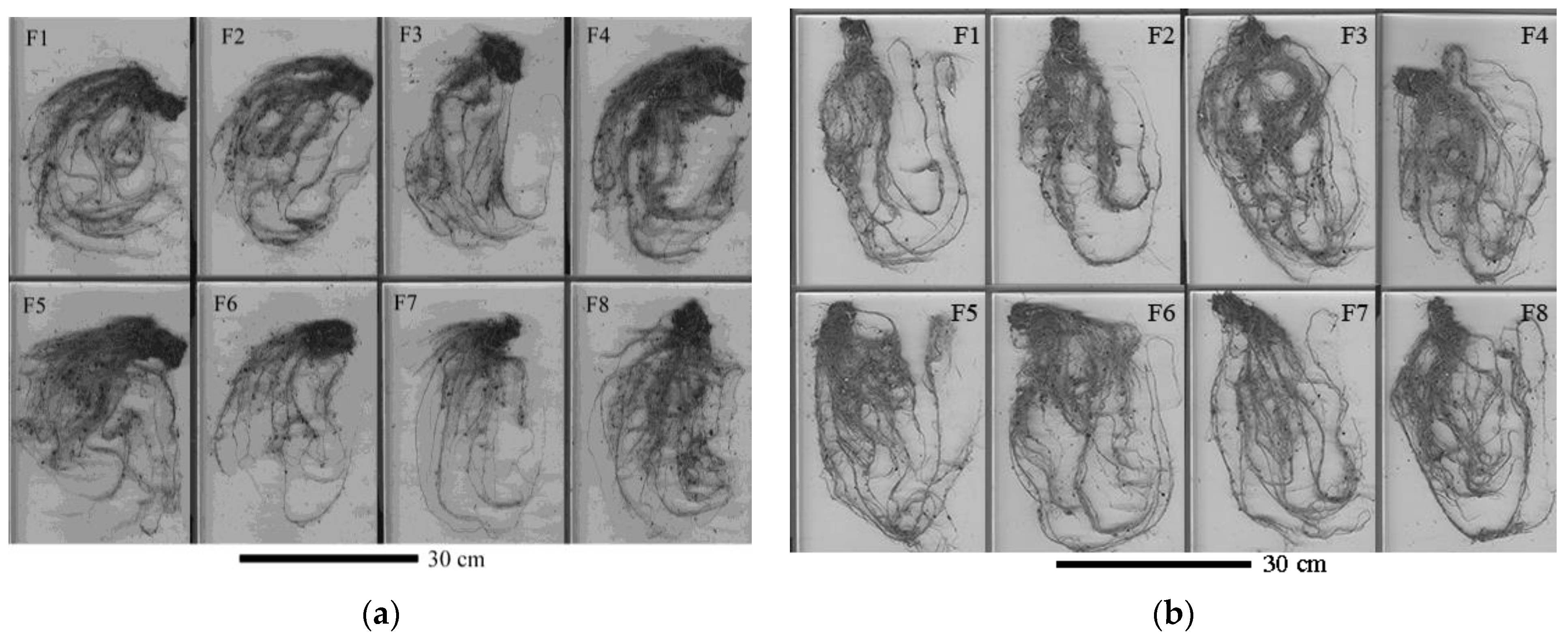


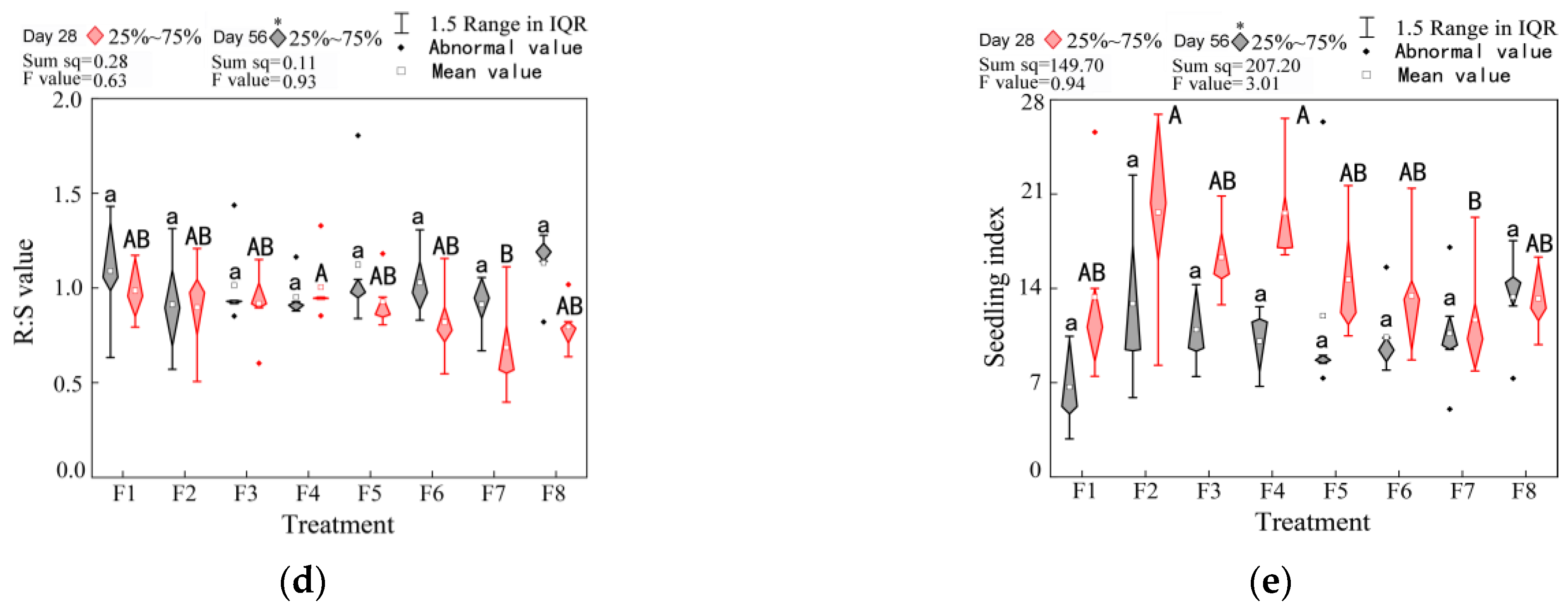

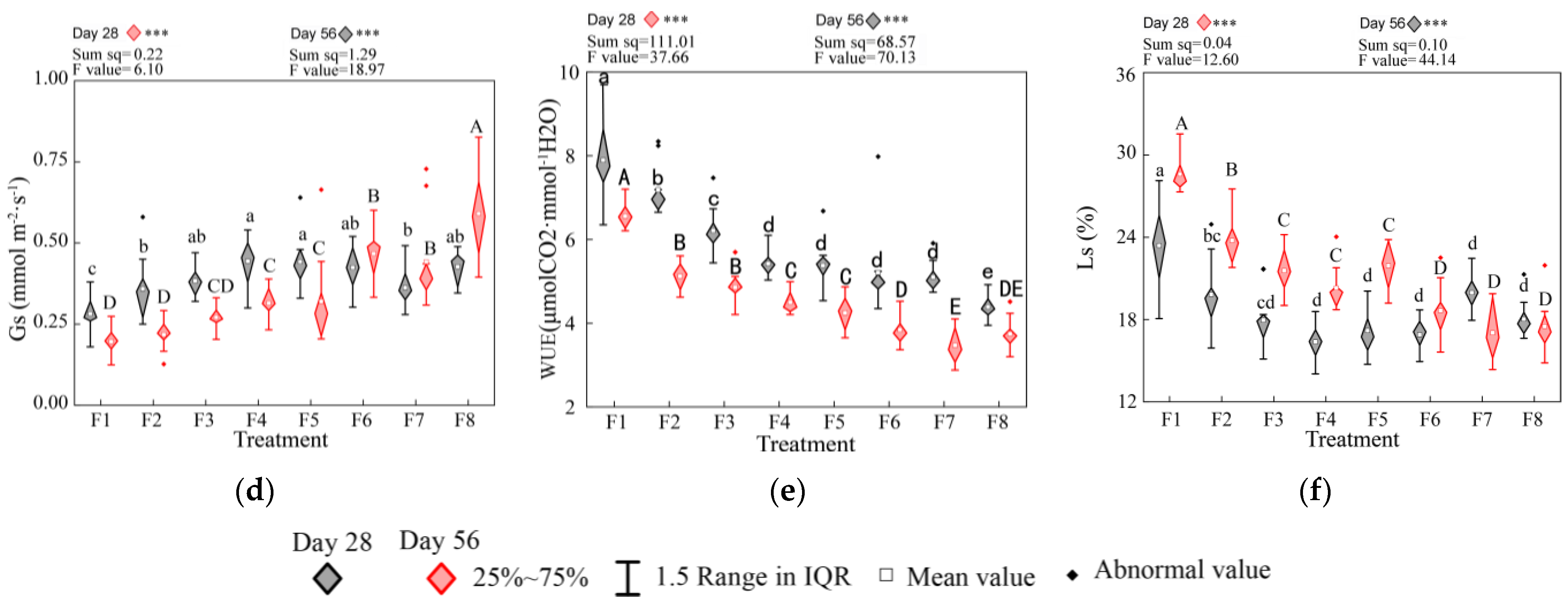


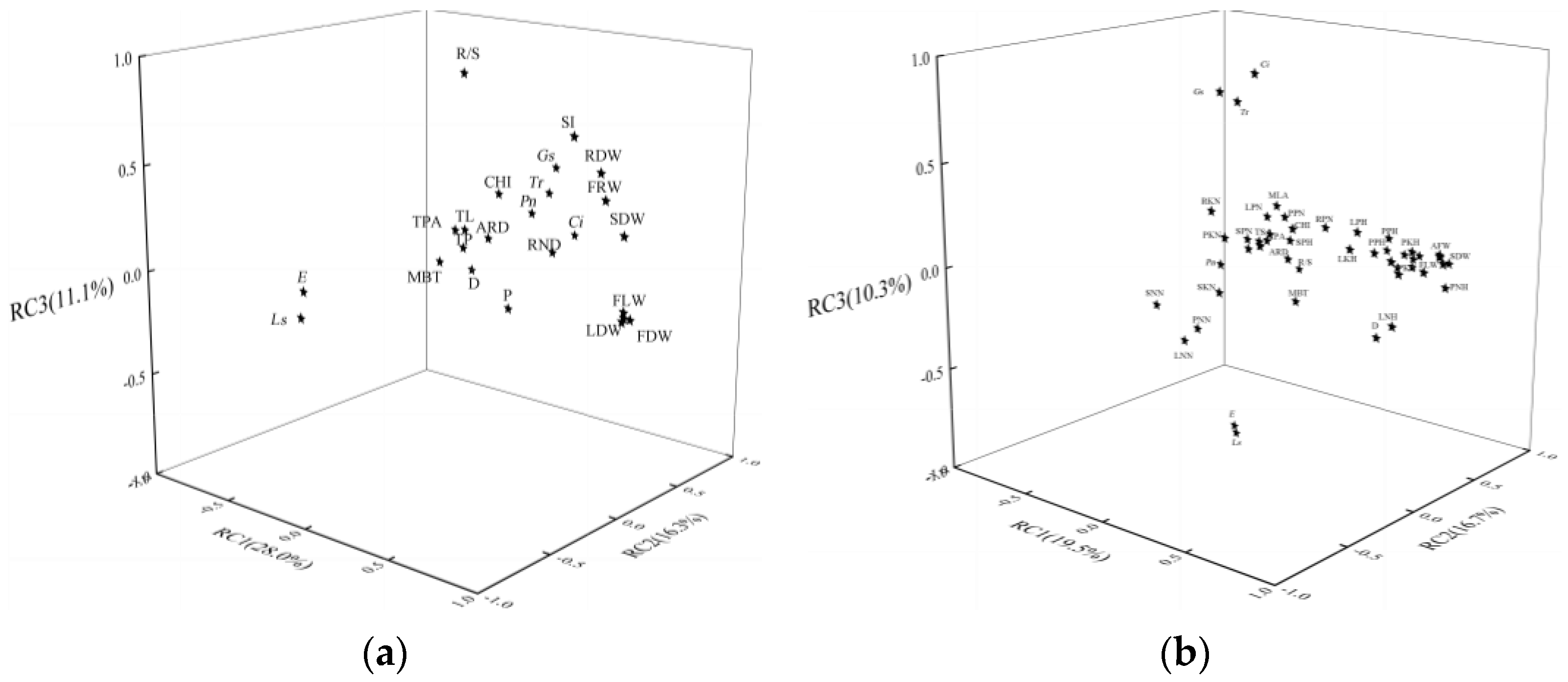
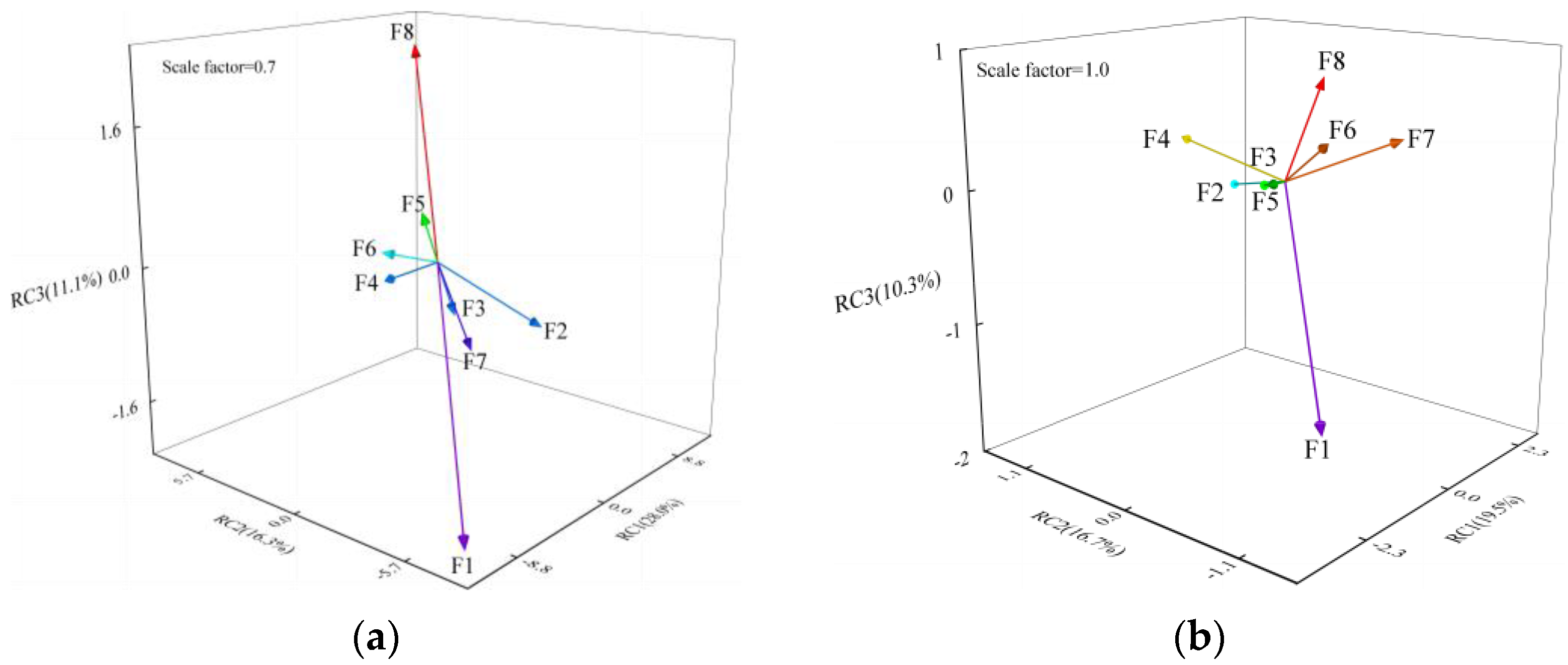
| Treatment | N Content 1 | P Content | K Content | Nutrient Mass Concentration | Product Content | Product and Ingredient Concentration |
|---|---|---|---|---|---|---|
| F1 | 0 | 0 | 0 | 0 | 0 | Water |
| F2 | 22.5 | 22.5 | 22.5 | 1.35% | 150 | Complex fertilizer 2-(Yara Trading) |
| F3 | 22.5 | 22.5 | 22.5 | 1.35% | 150 | Complex fertilizers 2-(HSC) |
| F4 | 15 | 40 | 20 | 1.5% | 370.5 | Potassium chloride (60%), ammonium bicarbonate (17.2%) and calcium superphosphate (16%) |
| F5 | 15 | 40 | 0 | 1.1% | 337.2 | |
| F6 | 20 | 40 | 0 | 1.2% | 366.3 | |
| F7 | 25 | 30 | 0 | 1.1% | 332.8 | |
| F8 | 10 | 20 | 0 | 0.6% | 146.7 | Urea (46%), and calcium superphosphate (16%) |
| Time | F1 | F2 | F3 | F4 | F5 | F6 | F7 | F8 |
|---|---|---|---|---|---|---|---|---|
| Day 28 | −4.637 | 0.945 | 0.052 | 1.17 | −0.013 | 0.076 | 0.115 | 1.873 |
| Day 56 | −7.920 | 3.515 | 1.157 | 3.597 | −0.385 | −0.863 | −1.161 | 2.060 |
| Variate-x | Variate-y | Correlation Coefficient | p-Value 1 |
|---|---|---|---|
| N content of F1 | Biomass | 0.899 | 0.000 *** |
| concentration | 0.369 | 0.108 | |
| N content of F2 | Biomass | 0.965 | 0.000 *** |
| concentration | 0.414 | 0.069 |
Disclaimer/Publisher’s Note: The statements, opinions and data contained in all publications are solely those of the individual author(s) and contributor(s) and not of MDPI and/or the editor(s). MDPI and/or the editor(s) disclaim responsibility for any injury to people or property resulting from any ideas, methods, instructions or products referred to in the content. |
© 2023 by the authors. Licensee MDPI, Basel, Switzerland. This article is an open access article distributed under the terms and conditions of the Creative Commons Attribution (CC BY) license (https://creativecommons.org/licenses/by/4.0/).
Share and Cite
Zhang, S.; Yang, J.; Ouyang, L.; Chen, S. The Effect of Soaking Root Fertilizer on Promoting the Seedling Early Growth and Root Development of Eucalyptus urograndis. Forests 2023, 14, 2013. https://doi.org/10.3390/f14102013
Zhang S, Yang J, Ouyang L, Chen S. The Effect of Soaking Root Fertilizer on Promoting the Seedling Early Growth and Root Development of Eucalyptus urograndis. Forests. 2023; 14(10):2013. https://doi.org/10.3390/f14102013
Chicago/Turabian StyleZhang, Shitao, Jiaqi Yang, Linnan Ouyang, and Shaoxiong Chen. 2023. "The Effect of Soaking Root Fertilizer on Promoting the Seedling Early Growth and Root Development of Eucalyptus urograndis" Forests 14, no. 10: 2013. https://doi.org/10.3390/f14102013





